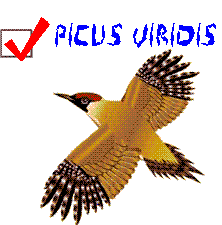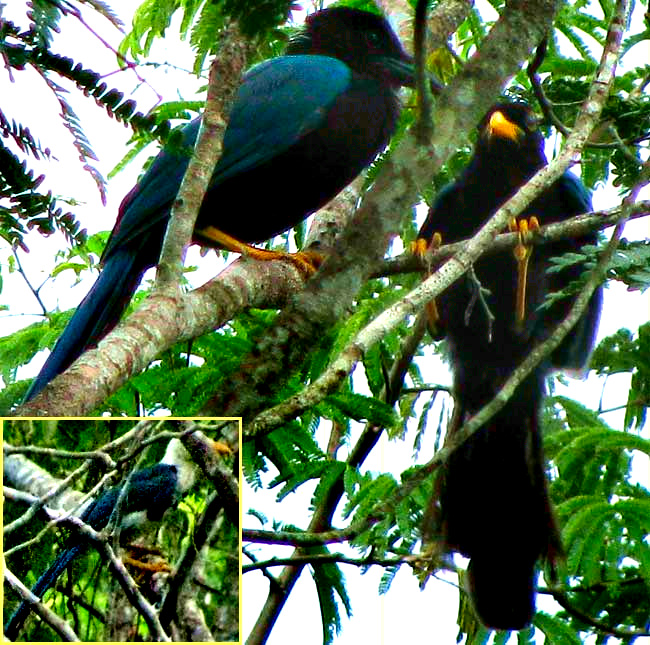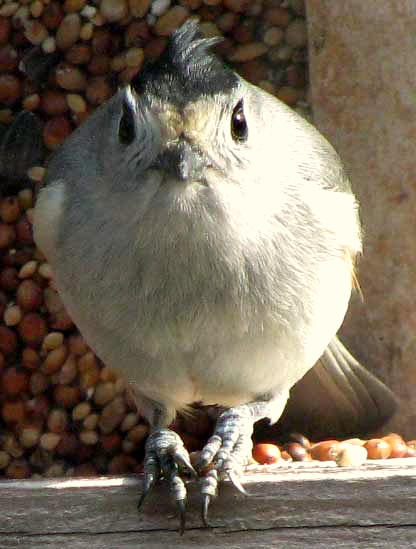 Most serious birders compile a Life List. It's a list of all the bird species they've identified with absolute certainty during their whole lifetime of serious birding. Being "serious" implies knowing about look-alike species and subspecies, the various plumage states, and having a systematic-enough mind to not be sloppy and haphazard when it comes to making the list.
Most serious birders compile a Life List. It's a list of all the bird species they've identified with absolute certainty during their whole lifetime of serious birding. Being "serious" implies knowing about look-alike species and subspecies, the various plumage states, and having a systematic-enough mind to not be sloppy and haphazard when it comes to making the list.
Life Lists are extremely important to many birders. Wherever particularly interesting birds congregate, you can bet that birders will be there "searching for the rare ones" to add to their Life Lists. Expensive cruises to the Antarctica and river trips to isolated regions of the Amazon are staged just for people hoping to add new birds to their Life List.
HOW MANY BIRDS WILL YOU LIST?

If you start your own Life List when you're young, and for some reason during the rest of your life you never travel beyond your neighborhood, you might well end up listing a hundred species or more -- many species being spotted during migration. If you should expand your birding trips to include local parks and nature reserves, you could end up with 300 or more species. Take a trip to Mexico's Yucatan region and maybe you'll see several bird species found nowhere on Earth other than in the Yucatan bioregion. One of those is Yucatan Jay, Cissilopoha yucatanicus, shown at the left. If somehow you were to see all the bird species ever sighted in all of North America, your list would hold over 900 names.
So far no one has seen all the earth's more than 9,000 bird species. There's an informal "600 Club" for birders who have listed more than 600 species, so listing that many is considered doing pretty well -- at least a very fine "start."ORGANIZING YOUR LIST
There are many ways to organize a Life List, including just writing down the English names in the order in which newly identified birds are seen, and this may be the most common approach for rank beginners. Below you can see a small sample from my own Life List. I'd structure it differently if I were starting out now instead of the 1970s, as is explained later. Still, it's one example of how it can be done, as well an example of a couple of problems to avoid. Here it is:
Alcedinidae
Alcedo atthis / Common Kingfisher vii-11-80-SPA
Alcedo cristata / Malachite Kingfisher i-28-90-MAD
Ceryl alcyon / Belted Kingfisher i-24-76-KY
Ceryl torquata / Ringed Kingfisher ii-14-77-GUA
Chloroceryle aenea / Pygmy Kingfisher iii-8-78-GUA
Chloroceryle americana / Green Kingfisher iii-8-78-GUA
Meropidae
Merops apiaster / Common Bee-eater viii-5-80-SPA
Merops superciliosus / Blue-cheeked Bee-eater i-31-90-MAD
Momotidae
Aspatha gularis / Blue-throated Motmot i-19-85-MEX
Eumomota superciliosa / Turquoise-browed Motmot ii-25-77-GUA
Momotus mexicanus / Russet-crowned Motmot ii-3-79-MEX
Momotus momota / Blue-crowned Motmot iii-24-76-MEX
Upupidae
Upupa epops / Hoopoe vii-11-80-SPA
CUCULIFORMES
Cuculidae
Centropus toulou / Black Coucal ii-1-90-MAD
Coccyzus americanus / Yellow-billed Cuckoo v-31-76-TN
Coccyzus erythrophthalmus / Black-billed Cuckoo x-2-76-KY
The headings CORACIIFORMES and CUCULIFORMES, are the formal names for two of the 40-odd bird orders. The Coraciiformes is the "Kingfisher Order," and the Cuculiformes is the "Cuckoo Order." In the list, family names end with the letters "ae," as in the "Cuculidae," which is the cuckoo family.
Back in the 1970s I knew enough to organize the list so that closely related birds were grouped together. In the above list, for instance, all kingfishers appear in one place, and all motmots in another. Such grouping answers at a glance the question, "Just how many species of kingfisher have I seen?" Also, it highlights the fact that kingfishers and motmots are closely related, which isn't immediately obvious in the field.

When I first saw tropical America's Squirrel Cuckoo, Piaya cayana, at the right, it was hard to believe it was a real cuckoo. However, when I compared it to other cuckoos on my list, finally it sank in that cuckoo species are somewhat large birds, tend to have long tails barred with black and white below, and short but thick and curved beaks. And the one in the picture has "zygodactyl" feet -- two toes forward, two backward -- like all other cuckoos, too. I've learned a lot from my Life List.
The main authority for establishing what's related to what, thus the order in which names should appear in your list, is the International Ornithological Congress (IOC). On the Internet their ever-evolving list is available at WorldBirdNames.Org's IOC Lists page. At the bottom of that page, you can click on "crows," for example, and skip to the crow section of this very long list.
Wikipedia has pages called "List of birds of Canada and the United States," as well as List of birds of Europe.
PROBLEMS WITH MY LIST
If I could go back and start my list anew, the main change I'd make would be to include the subspecies seen, if a subspecies was known to exist. Sometimes not only are two or more species "lumped" into one species, but also subspecies are elevated to the species level. Subspecies are not counted as species, but they're important to show on the list, in case a subspecies eventually is promoted or demoted.
Also, my list is vague about the where the birds were seen. My code -- such as iii-24-76-MEX -- indicates the date but only the state or country in which the bird was seen. If one day a Mexican species on my list has its three subspecies elevated to species level, with each subspecies occupying a different part of Mexico, and I've seen the bird all over Mexico, then if I can't find my record of exactly where I was when the birds were seen, I won't be able to claim with certainty any of the newly recognized species. In short, on your list, it's a good idea to be as specific as possible with your sighting locations.
ELECTRONIC LISTS
On a computer it's very easy to make a simple text page such as my own list shown above. Also, various apps are available to make listing easier and showier. The AllAboutBirds.Org website offers not only great information about making your lists, but also a free bird-listing phone-app, on its Merlin Bird ID app page.
WHY BOTHER?

Life Lists are fun! And looking over my hard-won entries gives immense satisfaction. Each entry evokes memories of travel in interesting places, and is nothing less than a "trophy" testifying to my bird-spotting successes!
Let's say you grow up in eastern North America where at the backyard bird-feeder over the years you've seen jillions of Tufted Titmice, Baeolophus bicolor. Then one glorious day you take a trip to visit a cousin in southwestern Texas and you see the bird at the right. It's just like your Tufted Titmouse, but the crest is solid black. You go look in your bird book and, sure enough, there's a Black-crested Titmouse, Baeolophus atricristatus, -- though some older field guides "lump" the two species. According to your field guide, that's a new species for your list, so it's a big day, and for the rest of your life when you see that name on the list you'll remember the very moment back in southwestern Texas when you were visiting your cousin and saw it.
TWO RULES FOR YOUR LIFE LIST
The big rule for your Life List is this: Don't list any species unless you're 100 percent sure your identification is correct.
Just as important is, Don't get so obsessed with collecting names that you begin ignoring the beauty of birds and bird habitats. For some unfortunate souls, their Life-Listing has taken on the character of obsessive stamp collecting. Just get a name, add it, and rush on to the next stop.
